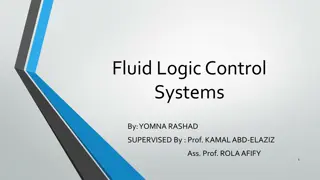Understanding the Inner Workings of FPGA and Complex Programming Logic Devices
Delve into the inner mechanisms of Field Programmable Gate Arrays (FPGA) and Complex Programming Logic Devices, examining components such as configurable logic blocks, lookup tables, function generators, multiplexers, and flip-flops. Explore the application of Shannon's Expansion Theorem in circuit design, alongside practical examples and visual representations of FPGA structures and operations.
- FPGA
- Complex Programming Logic Devices
- Shannons Expansion Theorem
- Configurable Logic Blocks
- Field Programmable Gate Arrays
Download Presentation

Please find below an Image/Link to download the presentation.
The content on the website is provided AS IS for your information and personal use only. It may not be sold, licensed, or shared on other websites without obtaining consent from the author. Download presentation by click this link. If you encounter any issues during the download, it is possible that the publisher has removed the file from their server.
E N D
Presentation Transcript
Lecture 11-1 FPGA We have finished combinational circuits, and learned registers. Now are ready to see the inside of an FPGA.
Complex Programming Logic Devices Xilinx XCR3064XL CPLD Function block (16 macrocells)= PLA Macrocell = a flip flop + multiplexers IA routes signals Input of function block Chap 9 C-H 2
Function Block and MC Signal from PLA -> marcocell -> I/O pin Use CAD tool to fit the design into the PLD. Chap 9 C-H 3
Field Programmable Gate Arrays (FPGA) Logic cell: configurable logic blocks (CLBs) Input/Output blocks (I/O blocks) Chap 9 C-H 4
Configurable Logic Block Inside a CLB: function generators (LUT), FFs, and MUXs LUT: lookup table (truth table) is a reprogrammable ROM (16 1-bit words) Chap 9 C-H 5
A Lookup Table (LUT) If we want F = abc (one minterm) 1110 (and F=1) + 1111 (and F=1) Or if we want F = a b c d + a b cd + abcd. (15 minterms) Require a single function generator. Program the LUT table to get what we want. This is a 4-variable function generator. Bit stored in the LUT. To be implemented a b c d F 0 0 0 0 0 0 0 0 1 1 0 0 1 0 1 .. 1 1 1 1 1 Chap 9 C-H 6
Application of Shannons Expansion Theorem What if # of variables > 4 variables f (x1, x2, xn) = xi f (x1, x2,..xi-1, 0, xi+1, xn) + xif (x1, x2,..xi-1, 1, xi+1, xn) = xi f0 + xif1 f (a, b, c, d, e) = a f(0, b, c, d, e) + a f(1, b, c, d, e) Let a = 0, what lefts are terms with b, c, d, e 2-1 MUX F = a I1+ a I2 Chap 9 C-H 7
Shannons Expansion Theorem: a majority function f = x1x2+ x1x3+ x2x3 = ~x1(x2x3) + x1(x2+x3+x2x3); //let x1= 0 for f, and let x1= 1 for f = ~x1(x2x3) + x1(x2+x3) What is the circuit using a 2-1 MUX for x1 ?
Shannons Expansion Theorem: XOR Ex: f = x1 = ~x1(0 = ~x1(x2 x2 x2 x3) + x1(1 x3) + x1~(x2 x3 x 1 x2 x3) x3) x2 f x1x2x3 f f = x1 x2 0 0 0 0 1 1 1 1 0 0 1 0 1 0 0 1 1 0 1 0 1 1 0 1 0 0 1 x2 x1 x2 x3 x3 1 0 1 0 1 f x2 x3
Shannons expansion for more than two variables f (x1, x2, xn) = xi f (x1, x2,..xi-1, 0, xi+1, xn) + xif (x1, x2,..xi-1, 1, xi+1, xn) = xi f0 + xif1 Say for x1and x2; f (x1, x2, xn) = x1 x2 f (0, 0, x3 xn) + x1 x2f (0, 1, x3 xn) + x1x2 f (1, 0, x3 xn) + x1x2f (1, 1, x3 xn) This expansion can be implemented by a 4-to-1 multiplexer where x1and x2 are the selection signals.























